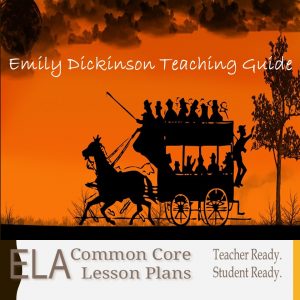I’ve compiled an analysis of Emily Dickinson poems to help you get started teaching. Here’s a link to some lesson ideas for teaching Emily Dickinson.
Quick Lesson Plan
Here’s a little something I threw together to make your visit to my site more useful and productive: Theme of Death in Emily Dickinson’s Poems.
I feel it’s important to give you something you can use in your classroom right now.
I’m Nobody! Who are you?

Just because you love discussing poetry doesn’t mean your students do. These lesson plans will help your students create intelligent discussion topics for several Emily Dickinson poems. Download. Print. Copy. Teach.
I’m nobody! Who are you?
Are you nobody, too?
Then there’s a pair of us–don’t tell!
They’d banish us, you know. How dreary to be somebody!
How public, like a frog
To tell your name the livelong day
To an admiring bog!
Analysis of “I’m Nobody! Who are you?”
Feel free to explain Emily Dickinson poems on your own. Here’s what I think.
Observations
- Rhyme Scheme: a a x a x b x b
- The first two lines introducing “I” and “You” form a couplet. Form mirrors content.
- Situational Irony – most people want to be a “somebody,” not Dickinson. She is relieved to find a kindred spirit who finds an admiring bog as something undesirable.
- Line 6: Simile comparing somebodies to frogs.
- “Bog” in line 8 is a pun. A bog is where frogs live. Bog also means something that slows you down, like a crowd. “Bog” also hints that nobody’s really listening anyway.
- Lines 3-4 contain a warning from the speaker in the poem to the other nobody that if somebody finds out about their nobodiness then they could be banished. Where to? The bog, a suitable place for banishment.
Analysis
“I’m nobody! Who are you?” comments on the poet’s desire to be left alone. She compares being somebody to being a frog that croaks all day without a response. Dickinson cautions her “nobody” friend, introduced to the reader in the opening couplet, the which structure establishes the two nobodies as people joined together, isolated, to not let the “somebodies” know who they are, for they will banish them to the bog, which symbolizes the crowd where “somebodies” congregate. In short, Dickinson comments on the human tendency to force/persuade non-conformists to follow the crowd.
Note: Odysseus in Homer’s The Odyssey understood the usefulness of being a nobody thousands of years before; unfortunately, he could not be a nobody for long.
Faith is a fine invention
When Gentlemen can see–
But Microscopes are prudent
In an Emergency.
Analysis of “Faith is a fine invention”
Feel free to explain Emily Dickinson poems on your own. Here’s what I think.
Observations
- Rhyme Scheme: x a x a
- Meter: iambic trimeter
- Microscope is a symbol of science and practicality.
- “Gentlemen who see” may symbolize ecclesiastical leaders.
Analysis
“Faith is a fine invention” compares the man of faith with the man of science. Although faith comes in handy for leadership and guidance, it is necessary to be practical and rely on physical senses as well. The fast paced iambic trimeter and the traditional quatrain rhyme scheme give the poem a sense of being an axiom–the futility of faith, if not tempered by pragmatism.
A bird came down the walk
He did not know I saw;
He bit an angle-worm in halves
And ate the fellow, raw.And then he drank a dew
From a convenient grass,
And then hopped sidewise to the wall
To let a beetle pass.He glanced with rapid eyes
That hurried all abroad,–
They looked like frightened beads, I thought;
He stirred his velvet headLike one in danger; cautious,
I offered him a crumb,
And he unrolled his feathers
And rowed him softer homeThan oars divide the ocean,
Too silver for a seam,
Or butterflies, off banks of noon,
Leap, splashless, as they swim.
Analysis of “A bird came down the walk”
Feel free to explain Emily Dickinson poems on your own. Here’s what I think.
Observations
- Rhyme Scheme: x a x a. In the final three stanzas, the a’s are off rhyme.
- Meter: Iambic trimeter except for the third line in each stanza, which is iambic tetrameter.
- The dash at the end of line 10 marks an abrupt change, the change from the bird doing what birds do to birds fearing human encroachment.
- Simile in line 11 – Bird’s eyes are compared to frightened beeds.
- Metaphor beginning in line 15 of the bird’s flight with the smooth movement of a boat.
Analysis
“A bird came down the walk” shows the disturbance caused by human encroachment on the world of nature. The first two stanzas employ a smooth-flowing meter and rhyme scheme as it describes a bird eating its breakfast and enjoying dew. The form and the mood of the poem change in stanza three as the bird is approached by a human, albeit a peaceful one. The bird becomes frightened, feeling something isn’t quite right, emphasized even more by the use of off-rhyme in stanzas 3-5. The bird recovers and flees the scene gracefully. Dickinson accomplishes the contrast despite the ironical observation that the bird in nature, the beautiful bird, commits the violent act of biting a worm in half and eating it raw, whereas the frightening of the bird and the disruption of nature occurs with the gentle, kind act of offering the bird crumbs.
